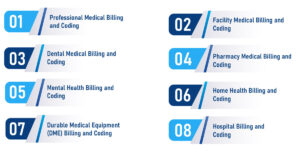The healthcare practice requires medical billing and coding to function properly. The creation of insurance claims by billers requires these codes as the foundation to submit claims to insurance companies for reimbursement. When medical billing and coding are properly managed, claims are less likely to be denied, and the revenue cycle performance becomes enhanced while healthcare regulations stay in compliance.
Similarly, positive effects come from process optimization, which enables medical staff to deliver care benefits and generate higher revenue. When healthcare facilities partner with professionals, they gain precise documentation alongside swift claim delivery and decreased administrative strain.
What Is Medical Billing and Coding?
Healthcare operations depend heavily on medical billing together with coding services. Medical coding functions as a process to convert health-related diagnoses alongside procedures into standardized numeric values. The standard medical codes originate from medical records, including physician documentation and laboratory test results.
In addition, medical billing professionals generate insurance claims, which they submit to insurance organizations for reimbursement. Healthcare providers receive payment for their Medical billing services because of this process.
Moreover, the two positions demand both precise attention to detail and medical terminology knowledge. The accurate maintenance of patient records and payment processes depends on their work. Billings, together with coding, creates an efficient system that operates throughout the healthcare industry.
Medical Billing and Coding Online Services
1. Claim Submission
Healthcare providers must prepare precise insurance claims, which they submit to third-party payers during the claim submission process. Therefore, the process includes complete patient and treatment information, which enhances the probability of receiving prompt reimbursement. The implementation of automation in online medical billing services shortens claim submission durations and lowers the occurrence of mistakes.
2. A/R Follow-Up
The A/R follow-up system serves to track down unpaid claims across the organization. The process works to address payment delays by fixing documentation problems and correcting coding errors. The prompt execution of follow-up procedures decreases the probability of unpaid claims.
3. Denial Management
The denial management process analyzes rejected claims to find denial causes while making required adjustments for resubmission. The system enables fast and correct resubmission of claims before approval. Efficient denial management processes help reduce lost revenue and enhance payment rates. The system helps solve payment issues that otherwise would cause delays in reimbursement payments.
4. Medical Coding
The healthcare industry requires medical coding to transform diagnosis labels and treatment methods and procedures into standardized insurance billing codes. Proper billing practices, along with regulatory compliance requirements, operate properly thanks to this method. With their assistance, medical coders can identify appropriate healthcare codes that lead to better reimbursement results.
5. Medical Credentialing
Medical credentialing processes verify healthcare providers’ qualifications to fulfill insurance requirements and regulatory standards. Online credentialing services provide rapid verification services. The system provides healthcare providers with a service to prevent reimbursement delays while supporting compliance with payer standards.
Types Of Medical Billing and Coding
There are several types of medical billing and coding with specific aspects of healthcare services. Here are the main types:

1. Professional Medical Billing and Coding
This involves billing and coding for services provided by individual healthcare providers, such as doctors, specialists, or therapists. It ensures that claims are submitted for office visits, consultations, and other professional medical billing services.
2. Facility Medical Billing and Coding
This type deals with billing for services provided in healthcare facilities like hospitals, outpatient clinics, and nursing homes. It includes inpatient and outpatient services, surgeries, diagnostic tests, and emergency care.
3. Dental Medical Billing and Coding
The practice of dental billing and coding handles services that dentists and orthodontists deliver to patients. Cleanings, fillings, and extractions, along with other dental treatments, comprise the procedures covered by dental medical billing and coding. The coding system for dental billing operates as an independent system from general medical billing codes.
4. Pharmacy Medical Billing and Coding
The medical billing process for pharmacies includes sending claims for prescription medicines together with their services. Pharmacy medical billing enables drug outlets to receive payment for their medication distribution which includes both prescription drugs and non-prescription products.
5. Mental Health Billing and Coding
The specific billing and coding system addresses mental health services, which include therapeutic sessions, psychiatric assessments, counseling sessions and medication administration. The system enables healthcare providers to correctly document mental health diagnoses together with treatment procedures.
6. Home Health Billing and Coding
Home health medical billing and coding operate to process payments for nursing care phy, physical therapy, and home health aide services delivered within patient homes. The system enables proper coding to obtain reimbursement.
7. Durable Medical Equipment (DME) Billing and Coding
The reimbursement method for DME billing covers payments for medical equipment that includes wheelchairs and oxygen tanks along with prosthetics. Medical equipment and supply reimbursement claims can be submitted correctly through this medical billing system.
8. Hospital Billing and Coding
Medical services and facility stay information along with diagnostic examinations and treatment methods and procedures make up the coding process. The system provides radiological examinations together with laboratory diagnostic procedures as part of its service delivery.
Guidelines For Error-Free Coding Services
The following bullet points outline the procedures for delivering error-free coding services:
- The coding process requires the use of the most current versions of ICD-10 and CPT and HCPCS code books.
- The service maintains full compliance with present payer regulations and regulatory requirements.
- Knowledge of anatomy and clinical terms must be strong to perform error-free coding services.
- The selected codes must double-check that they align with the available documentation in the notes.
- It is necessary to refrain from making assumptions or using guesses when performing coding tasks.
- The use of correct coding practices prevents audits and penalties.
Denial Management in Medical Billing
The process of denial management involves both claim identification and correction work to obtain insurance payment for healthcare services. Denial management helps healthcare providers receive payment for their service delivery.
Furthermore, the process combines tracking with analysis of trends and prevention of future denials. Our organization takes steps to minimize payment delays while improving financial stream practices. The practice benefits from a strong revenue cycle through this system.
End Note
Accurate claim submission and timely reimbursement heavily depend on medical billing and coding. The healthcare provider uses these standardized codes to translate patient encounters, dia, gnoses, and treatment methods for insurance company processing.
However, correct coding practices lower the likelihood of denied claims and measurement errors, which saves time and resources. Physicians can maintain thorough medical records as they utilize this process while payer organizations receive straightforward correspondence. If you need a virtual staff that handles all your billing-related tasks, you may reach out to us at MAVA Care. We are here to assist and maintain a smooth revenue cycle for your practice.









